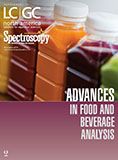Detection and Quantitation of Pyrrolizidine Alkaloids in Diverse Food Matrices
A new method enables quantification of pyrrolizidine alkaloids in a range of food matrices.
Thousands of plants produce pyrrolizidine alkaloids as a natural defense mechanism against insects and small animals. The presence of these compounds in human food and animal feed, however, is a concern because of their potential threat to human health. Foods that are of particular concern include honey, certain herbs and teas, dietary supplements, and animal-derived products like milk and eggs. In an effort to better detect pyrrolizidine alkaloids in the food supply, Jean-François Picron, PhD, and his colleagues from Sciensano in Belgium, recently developed new ultrahigh-pressure liquid chromatography–tandem mass spectrometry (UHPLC–MS/MS) methods for the quantification of pyrrolizidine alkaloids in a range of food matrices. His group also completed dietary exposure assessments in support of Belgian and European regulatory guidelines. In this interview, Picron discusses this work.
Q: Why is it important to study pyrrolizidine alkaloids in foods?
A: Pyrrolizidine alkaloids are emerging contaminants in food. These common secondary plant metabolites defend against herbivores and are produced by more than 6,000 plant species. They are thought to be one of the most widespread plant toxins in the world.
1,2-unsaturated pyrrolizidine alkaloids are carcinogenic and genotoxic, and they can affect wildlife, livestock, and humans through contaminated food consumption. Cases of human poisoning, mainly involving acute and chronic liver damage, have been documented.
The European Food Safety Authority (EFSA) has published different opinions about the risk of pyrrolizidine alkaloids to human health since 2011, but their efforts have been hampered by a lack of analytical methods. So, it was very important to develop analytical methods that could accurately quantify very low levels of pyrrolizidine alkaloids in a wide range of food items, in order to cover the diet as completely as possible.
Q: You developed a method to quantify pyrrolizidine alkaloids in food. Can you briefly describe the method and why you chose the technique that you did?
A: In fact, we developed nine different analytical methods for different kinds of food matrices. The food matrices were grouped into nine families of foods with similar composition, such as fat or protein content.
All the analytical methods follow the same workflow: first, liquid acidic extraction of the analytes, and then solid-phase extraction of the crude extract to remove interfering compounds that could lead to a major matrix effect.
We chose liquid chromatography for the analysis. Pyrrolizidine alkaloids are found in two different forms: the tertiary amine and the corresponding N-oxide. Gas chromatography would have degraded the thermally unstable N-oxides, which is not the case with liquid chromatography. Moreover, ultrahigh performance liquid chromatography (UHPLC) instruments have great advantages over HPLC instruments for the quantitation of pyrrolizidine alkaloids because of their higher resolving power and greater sensitivity. The coupling of UHPLC with tandem mass spectrometry (MS/MS) enables high reliability and sensitivity, making this method the perfect choice for pyrrolizidine alkaloid analysis.
Q: How did you address the challenge of dealing with the wide range of food matrices? What other challenges did you face in developing the methods?
A: We targeted a diverse range of food items, such as honey, honey-based products, fresh meat, processed meat, dairy products, plant products (dry and wet), and infusions (teas). We had to adjust the type and concentration of the acid used for the extraction step for each matrix, as well as the stationary phase used for the solid-phase extraction step.
Another major problem of pyrrolizidine alkaloid analysis was that we had to find matrix blanks to build a calibration curve, which was tricky for some matrices. For example, we had to build artificial matrices in the lab for some matrices, such as inverted sugar syrup for the analysis of honey.
Another big problem for pyrrolizidine alkaloid analysis is the limited availability of analytical standards. There are more than 300 known toxic pyrrolizidine alkaloids, but standards are only commercially available for about 30 compounds. All those compounds were included in our methods.
The most complicated matrices were those with the highest protein content, especially cheeses. It took a long time to find a good compromise between sensitivity and recoveries, and we found that adding a lot of salt helped with protein denaturation.
As the human health risk of pyrrolizidine alkaloids is currently uncertain, and their prevalence in foods is uncertain, we had to target limits of quantification that were as low as possible to detect the most pyrrolizidine alkaloids possible. With our methods, the limit of quantification for all matrices was below 1 ppb, and even as low as ppt levels for dairy products.
Another bottleneck for the analysis of pyrrolizidine alkaloids is the coexistence of many isomers. So, you have to carefully optimize your LC gradient. We were able to achieve that, and separate most of the isomers.
Q: You used your methods to study the presence of these compounds in products on the Belgian market. How did you conduct that study, and what did you find?
A: First, we established a structured sampling plan to cover the widest range of food items that also covers a complete diet. We bought and analyzed more than 1,300 food items available on the Belgian market, and our research delivered many interesting results.
For example, we reported for the first time high levels of europine in Mediterranean honeys, and thanks to our very low limits of quantitation in dairy products and meats, we suggested for the first time that N-oxides are present in animal-based products. Previous researchers suggested that the N-oxides were totally converted to the amine during the animal's metabolism. But, in fact, the previous analytical methods had lower sensitivity, so it was not possible to detect N-oxides with those methods.
On the other side of the contamination scale, we showed that plant-based food supplements were contaminated with ppm levels of pyrrolizidine alkaloids, even if they are not labeled as containing a pyrrolizidine alkaloid-producing plant. So, we found a wide range of contamination between ppt and ppm levels.
Also, the transfer rate between the contamination of pyrrolizidine alkaloids in herbal teas, from the dry material to the infusion, is incomplete. In fact, only about 20% of the contamination, depending on the compounds' structures, are effectively transferred to the infusion. This result is quite interesting, because, so far, EFSA has only applied a dilution factor from the dried extract, assuming a total transfer of pyrrolizidine alkaloids. This is quite good news for the risk evaluation.
Q: Your initial study led to a follow-up study on aromatic herbs. Why were the aromatic herbs studied separately? And what did you find in that part of the study?
A: In the main project, the study of aromatic herbs was not planned, but we were interested in analyzing some samples with our methods. The results of a few categories of dry mixes were very surprising. We found high levels of contamination in Italian mixes for pizza and pastas. So, we decided to conduct a follow-up project with a pragmatic approach.
The first step was to determine if aromatic herbs as such could produce pyrrolizidine alkaloids, and the results showed that they do not. After that, we obtained a large range of individual herbs and mixes. Most of them were contaminated, sometimes at ppm levels. Oregano was by far the most problematic herb with a high degree of contamination, sometimes with levels above 10 ppm. In this case, the contamination of oregano is clearly due to co-harvesting, because oregano, as such, cannot produce the contaminants. Some other research groups are currently studying the question of whether economic adulteration of oregano is leading to its contamination.
The contamination pattern in aromatic herbs was quite remarkable, and it was largely dominated by heliotrine-type compounds. In fact, the EFSA recently proposed to reduce the number of PAs to be monitored in food excluding the majority of heliotrine-type compounds. Maybe with this result, EFSA will reconsider the question because the contamination levels are quite significant.
Q: Once you had data about the contamination levels of these compounds in foods, how did you assess exposure levels and public risk, and what conclusion did you come to?
A: The analytical concentrations were linked to consumption data collected in a 2014 survey in Belgium. We calculated the mean PAs concentration for each kind of food item for the sum of the 30 targeted compounds.
The result showed that from the 90thpercentile of the population, there is a significant increase in the intake of pyrrolizidine alkaloids. And if we compare the data with the previous EFSA exposure assessment, the median and the 95th percentile are quite comparable at the higher limits.
A notable point is that dairy products were, by far, the biggest contributor to one's intake of pyrrolizidine alkaloids, even though these matrices exhibited the lowest concentration levels.
For a risk assessment, it's important to use a margin of exposure approach for carcinogens and genotoxic compounds. The results showed that, if we use this approach, there is a health concern for about 10% of the population that is highly exposed to pyrrolizidine alkaloids.
Q: Do consumers need to worry about how much they're consuming of these compounds?
A: Consumers should adopt a varied diet. Change the brand of your milk and do not always drink the same tea. That way, you will probably dilute your potential exposure to pyrrolizidine alkaloid contamination.
Dr. Jean-Francois Picron

Dr. Jean-François Picron obtained his Master Degree in Chemistry in 2007 from the Free University of Brussels (ULB), where he continued with a PhD Degree in organic synthesis of supramolecular receptors called calixarenes, and the studies of their physicochemical properties using NMR spectroscopy. In 2015, he joined the Organic contaminants and Additives" Unit of Sciensano, where he works in the frame of natural toxins, particularly pyrrolizidine alkaloids, by developing new UPLC-MS/MS methods for their quantification in a wide range of food matrices, with an additional focus on dietary exposure assessments to support Belgian and European regulatory guidelines. In 2018, he also became involved in biomonitoring studies for pesticide residues.

Characterizing Plant Polysaccharides Using Size-Exclusion Chromatography
April 4th 2025With green chemistry becoming more standardized, Leena Pitkänen of Aalto University analyzed how useful size-exclusion chromatography (SEC) and asymmetric flow field-flow fractionation (AF4) could be in characterizing plant polysaccharides.
Investigating the Protective Effects of Frankincense Oil on Wound Healing with GC–MS
April 2nd 2025Frankincense essential oil is known for its anti-inflammatory, antioxidant, and therapeutic properties. A recent study investigated the protective effects of the oil in an excision wound model in rats, focusing on oxidative stress reduction, inflammatory cytokine modulation, and caspase-3 regulation; chemical composition of the oil was analyzed using gas chromatography–mass spectrometry (GC–MS).










